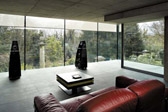
The shape of a room, what it contains, and the textures and materials that are used throughout are just a few of the things that can affect audio quality and how sound is delivered.

The environment you listen to your audio in can actually be as important as the equipment itself. For that reason, it’s worth considering where you will be putting your new gear before you commit to an investment.
Why are acoustics important?
Getting the acoustics of your room right allows you to hear the sound the way the creator intended it. When you are in a room, you don’t just hear the sound from your speakers – you are also listening to the sonic reflections from your walls, floors and ceilings. A number of factors in the room alter the sound, including the size and shape of the room, the materials that make up the walls, floors and ceilings and any windows or doors that are present.
That is why you can have your room acoustically treated – these treatments absorb reflected sounds, so that the original sonic image is not interfered with by your surroundings. Acoustic treatment materials have a structure that allows sound to pass through them in a way that uses up lots of the sonic energy, thereby reducing the noise that comes back out of them.
Acoustic designers
It is worthwhile speaking to a professional acoustic designer to optimise your listening environment. Acoustic designers create layout-style plans for shape, size and placement of speakers, people and treatments. Then they detail anything specific to the design, like door construction and sealing, wall construction/isolation, and ventilation and/or air-conditioning requirements.
It is the acoustic designer’s job to advise people to moderate their soundproofing plans to keep them in line with other things influencing the level of soundproofing. For example, there is no need to spend a fortune on highly soundproof walls if the doors are not suitable.
It is not just your room’s structure, cabinets, chairs and floor coverings that will affect the acoustics. Acoustic designers tend to stay out of aesthetic design, but they do need to know where they can put things and what they can hide things behind.
Benefits
By minimising early reflection points and making sure the low-frequency response is as tight and smooth as possible you will find that when watching movies the dialogue is clear, the sound effects and imaging work in unison and the bass is exciting and powerful. It also fixes the very common and frustrating problem of needing to turn up the volume in quiet dialogue scenes, only to be deafened when an explosion happens.
A good way of explaining how acoustic designs work is with the analogy of light and vision – if you can imagine watching a movie on a screen in a glass-walled, sunny room with bright lights on, then closing the curtains and turning the lights off, that’s pretty much what happens when acoustic treatment is applied to an otherwise untreated room.
Our hearing is remarkably sensitive to differences in level and direction and we can interpret sound very accurately. Sound reflected from walls, ceilings and other surfaces near us can interfere with the direct sound from the speakers and trick us into thinking it came from somewhere else.
This is worsened at low frequencies, where the addition of mass has even less effect because we are in what is known as the resonance-dominated region of the wall. Here, adding mass to the wall is just like going to a heavier guitar string – the resonance frequency simply gets lower but the magnitude of the resonance is unchanged and the problem simply shifts.
So, before you think about furnishing a media room or splurging out on new equipment, speak to a professional acoustic designer to optimise your listening environment, and get the most out of your audio.





